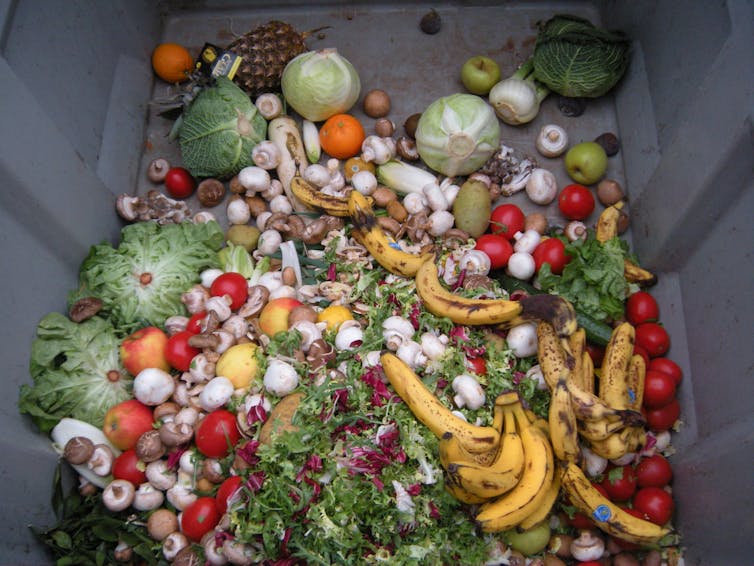
Volcanic ash plume from Ethiopia moving over North India will not impact AQI: Experts

TinyML: The Small Technology Tackling the Biggest Climate Challenge

What are climate tipping points? They sound scary, especially for ice sheets and oceans, but there’s still room for optimism
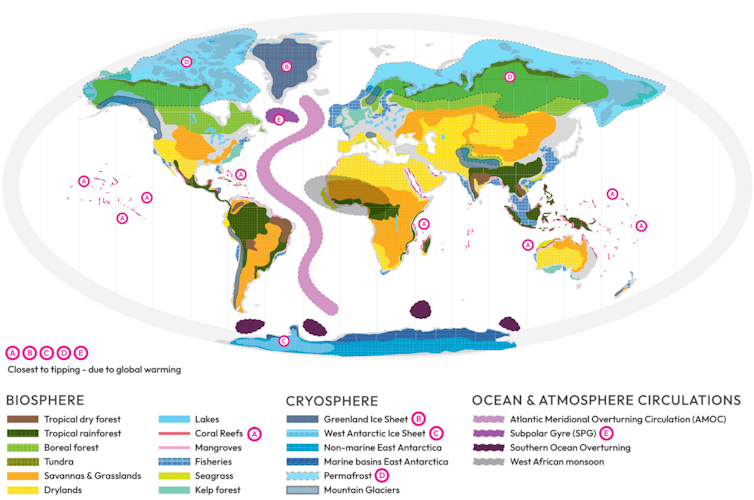 Pink circles show the systems closest to tipping points. Some would have regional effects, such as loss of coral reefs. Others are global, such as the beginning of the collapse of the Greenland ice sheet. Global Tipping Points Report, CC BY-ND
Pink circles show the systems closest to tipping points. Some would have regional effects, such as loss of coral reefs. Others are global, such as the beginning of the collapse of the Greenland ice sheet. Global Tipping Points Report, CC BY-NDScientists have long warned that if global temperatures warmed more than 1.5 degrees Celsius (2.7 Fahrenheit) compared with before the Industrial Revolution, and stayed high, they would increase the risk of passing multiple tipping points. For each of these elements, like the Amazon rain forest or the Greenland ice sheet, hotter temperatures lead to melting ice or drier forests that leave the system more vulnerable to further changes.
Worse, these systems can interact. Freshwater melting from the Greenland ice sheet can weaken ocean currents in the North Atlantic, disrupting air and ocean temperature patterns and marine food chains.
 Pink circles show the systems closest to tipping points. Some would have regional effects, such as loss of coral reefs. Others are global, such as the beginning of the collapse of the Greenland ice sheet. Global Tipping Points Report, CC BY-ND
Pink circles show the systems closest to tipping points. Some would have regional effects, such as loss of coral reefs. Others are global, such as the beginning of the collapse of the Greenland ice sheet. Global Tipping Points Report, CC BY-NDWith these warnings in mind, 194 countries a decade ago set 1.5 C as a goal they would try not to cross. Yet in 2024, the planet temporarily breached that threshold.
The term “tipping point” is often used to illustrate these problems, but apocalyptic messages can leave people feeling helpless, wondering if it’s pointless to slam the brakes. As a geoscientist who has studied the ocean and climate for over a decade and recently spent a year on Capitol Hill working on bipartisan climate policy, I still see room for optimism.
It helps to understand what a tipping point is – and what’s known about when each might be reached.
Tipping points are not precise
A tipping point is a metaphor for runaway change. Small changes can push a system out of balance. Once past a threshold, the changes reinforce themselves, amplifying until the system transforms into something new.
Almost as soon as “tipping points” entered the climate science lexicon — following Malcolm Gladwell’s 2000 book, “The Tipping Point: How Little Things Can Make a Big Difference” — scientists warned the public not to confuse global warming policy benchmarks with precise thresholds.
The scientific reality of tipping points is more complicated than crossing a temperature line. Instead, different elements in the climate system have risks of tipping that increase with each fraction of a degree of warming.
For example, the beginning of a slow collapse of the Greenland ice sheet, which could raise global sea level by about 24 feet (7.4 meters), is one of the most likely tipping elements in a world more than 1.5 C warmer than preindustrial times. Some models place the critical threshold at 1.6 C (2.9 F). More recent simulations estimate runaway conditions at 2.7 C (4.9 F) of warming. Both simulations consider when summer melt will outpace winter snow, but predicting the future is not an exact science.
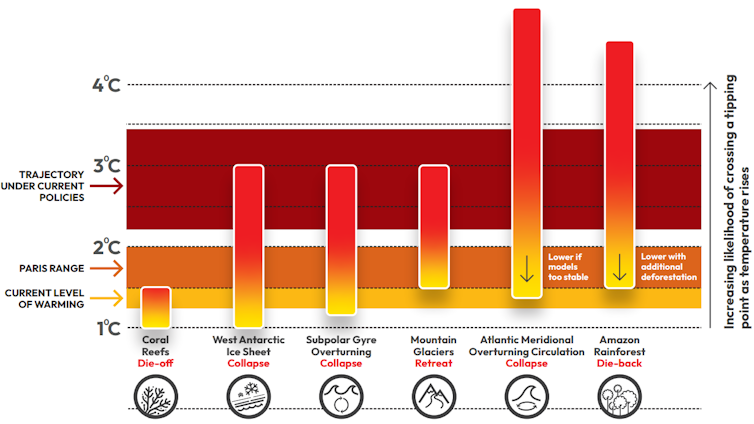 Gradients show science-based estimates from the Global Tipping Points Report of when some key global or regional climate tipping points are increasingly likely to be reached. Every fraction of a degree increases the likeliness, reflected in the warming color. Global Tipping Points Report 2025, CC BY-ND
Gradients show science-based estimates from the Global Tipping Points Report of when some key global or regional climate tipping points are increasingly likely to be reached. Every fraction of a degree increases the likeliness, reflected in the warming color. Global Tipping Points Report 2025, CC BY-NDForecasts like these are generated using powerful climate models that simulate how air, oceans, land and ice interact. These virtual laboratories allow scientists to run experiments, increasing the temperature bit by bit to see when each element might tip.
Climate scientist Timothy Lenton first identified climate tipping points in 2008. In 2022, he and his team revisited temperature collapse ranges, integrating over a decade of additional data and more sophisticated computer models.
Their nine core tipping elements include large-scale components of Earth’s climate, such as ice sheets, rain forests and ocean currents. They also simulated thresholds for smaller tipping elements that pack a large punch, including die-offs of coral reefs and widespread thawing of permafrost.
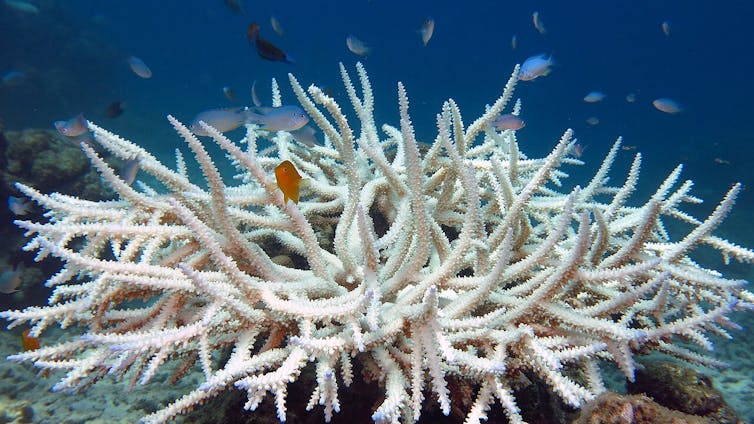 The world may have already passed one tipping point, according to the 2025 Global Tipping Points Report: Corals reefs are dying as marine temperatures rise. Healthy reefs are essential fish nurseries and habitat and also help protect coastlines from storm erosion. Once they die, their structures begin to disintegrate. Vardhan Patankar/Wikimedia Commons, CC BY-SA
The world may have already passed one tipping point, according to the 2025 Global Tipping Points Report: Corals reefs are dying as marine temperatures rise. Healthy reefs are essential fish nurseries and habitat and also help protect coastlines from storm erosion. Once they die, their structures begin to disintegrate. Vardhan Patankar/Wikimedia Commons, CC BY-SA
Some tipping elements, such as the East Antarctic ice sheet, aren’t in immediate danger. The ice sheet’s stability is due to its massive size – nearly six times that of the Greenland ice sheet – making it much harder to push out of equilibrium. Model results vary, but they generally place its tipping threshold between 5 C (9 F) and 10 C (18 F) of warming.
Other elements, however, are closer to the edge.
Alarm bells sounding in forests and oceans
In the Amazon, self-perpetuating feedback loops threaten the stability of the Earth’s largest rain forest, an ecosystem that influences global climate. As temperatures rise, drought and wildfire activity increase, killing trees and releasing more carbon into the atmosphere, which in turn makes the forest hotter and drier still.
By 2050, scientists warn, nearly half of the Amazon rain forest could face multiple stressors. That pressure may trigger a tipping point with mass tree die-offs. The once-damp rain forest canopy could shift to a dry savanna for at least several centuries.
Rising temperatures also threaten biodiversity underwater.
The second Global Tipping Points Report, released Oct. 12, 2025, by a team of 160 scientists including Lenton, suggests tropical reefs may have passed a tipping point that will wipe out all but isolated patches.
Corals rely on algae called zooxanthellae to thrive. Under heat stress, the algae leave their coral homes, draining reefs of nutrition and color. These mass bleaching events can kill corals, stripping the ecosystem of vital biodiversity that millions of people rely on for food and tourism.
Low-latitude reefs have the highest risk of tipping, with the upper threshold at just 1.5 C, the report found. Above this amount of warming, there is a 99% chance that these coral reefs tip past their breaking point.
Similar alarms are ringing for ocean currents, where freshwater ice melt is slowing down a major marine highway that circulates heat, known as the Atlantic Meridional Overturning Circulation, or AMOC.
A weaker current could create a feedback loop, slowing the circulation further and leading to a shutdown within a century once it begins, according to one estimate. Like a domino, the climate changes that would accompany an AMOC collapse could worsen drought in the Amazon and accelerate ice loss in the Antarctic.
Questions about closeness of other tipping points
Not all scientists agree that an AMOC or rain forest collapse is close.
In the Amazon, researchers recognize the forest’s changes, but some have questioned whether some of the modeled vegetation data that underpins tipping point concerns is accurate. In the North Atlantic, there are similar concerns about data showing a long-term trend.
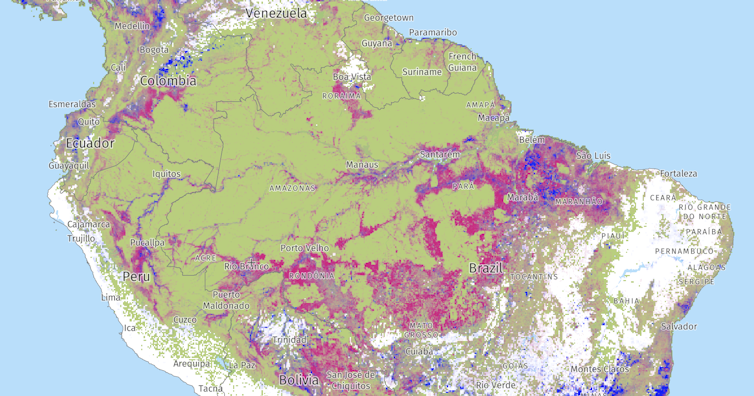 The Amazon forest has been losing tree cover to logging, farming, ranching, wildfires and a changing climate. Pink shows areas with greater than 75% tree canopy loss from 2001 to 2024. Blue is tree cover gain from 2000 to 2020. Global Forest Watch, CC BY
The Amazon forest has been losing tree cover to logging, farming, ranching, wildfires and a changing climate. Pink shows areas with greater than 75% tree canopy loss from 2001 to 2024. Blue is tree cover gain from 2000 to 2020. Global Forest Watch, CC BYOther changes driven by rising global temperatures, like melting permafrost, could be reversed. Permafrost, for example, could refreeze if temperatures drop again.
Risks are too high to ignore
Despite the uncertainty, tipping points are too risky to ignore. Rising temperatures put people and economies around the world at greater risk of dangerous conditions.
But there is still room for preventive actions – every fraction of a degree in warming that humans prevent reduces the risk of runaway climate conditions. Reducing greenhouse gas emissions slows warming and tipping point risks.
Tipping points highlight the stakes, but they also underscore the climate choices humanity can still make to stop the damage.
This article was updated to clarify permafrost discussion.![]()
Alexandra A Phillips, Assistant Teaching Professor in Environmental Communication, University of California, Santa Barbara
This article is republished from The Conversation under a Creative Commons license. Read the original article.
In 2024, the climate crisis worsened in all ways. But we can still limit warming with bold action
 The flooded Guadalupe River near Kerrville, Texas, in July 2025. OregonStateUniversity/flickr, CC BY-NC
The flooded Guadalupe River near Kerrville, Texas, in July 2025. OregonStateUniversity/flickr, CC BY-NCClimate change has been on the world’s radar for decades. Predictions made by scientists at oil giant Exxon in the early 1980s are proving accurate. The damage done by a hotter, more chaotic world is worsening and getting more expensive.
Even so, many countries around the world are failing to meet their emissions targets, with major gaps found even this week between the commitments and actions needed to hold global warming to 1.5°C.
This has put Earth on a dangerous path, as our new report on the state of the climate reveals.
Earth’s vital signs ailing
Last year was the hottest on record. It was also likely the hottest in at least 125,000 years.
Every year, we track 34 of the planet’s vital signs. In 2024, 22 of these indicators were at record levels. Carbon dioxide levels in the atmosphere and ocean heat both hit new highs, as did losses of trees to fire. Meat consumption kept rising and fossil fuels consumption reached new heights.
 Examples of vital signs, including carbon dioxide emissions, global tree cover loss to fire and energy consumption from different sources. State of the Climate 2025
Examples of vital signs, including carbon dioxide emissions, global tree cover loss to fire and energy consumption from different sources. State of the Climate 2025The consequences of climate inaction are ever more clear. In 2024, the world’s coral reefs suffered the most widespread bleaching ever recorded, affecting roughly 84% of the world’s coral reef area between January 2023 and May 2025.
Greenland and Antarctic ice mass fell to record lows. Deadly and costly disasters surged, including the flooding in Texas which killed at least 135 people while the Los Angeles wildfires have cost more than A$380 billion. Since 2000, global climate-linked disasters have now caused more than $27 trillion in damages.
 The flooded Guadalupe River near Kerrville, Texas, in July 2025. OregonStateUniversity/flickr, CC BY-NC
The flooded Guadalupe River near Kerrville, Texas, in July 2025. OregonStateUniversity/flickr, CC BY-NCStories and statistics like this are sadly not new. Many other reports and warnings have been published before we started this annual snapshot in 2020. Therefore, our report this year focuses on three high-impact types of climate action, across energy, nature and food.
Energy
Combined solar and wind consumption set a new record in 2024 but is still 31 times lower than fossil fuel (oil, coal, gas) energy consumption. This is despite the fact renewables are now the cheapest choice for new energy almost everywhere. One reason for this are the ongoing subsidies for fossil fuels.
By 2050, solar and wind energy could supply nearly 70% of global electricity. But this transition requires restricting the influence of the fossil fuel industry and a full phase out of fossil fuel production and use, not the expansion we continue to see globally.
As a result of surging fossil fuel consumption, energy-related emissions rose 1.3% in 2024 and reached an all-time high of 40.8 gigatons (Gt) of carbon dioxide equivalent. In 2024, the greatest fossil fuel greenhouse gas emitters were China (30.7% of total), the United States (12.5%), India (8.0%), the European Union (6.1%), and Russia (5.5%). Together, they accounted for 62.8% of global emissions.
Sadly, much of the rise in fossil fuel electricity generation may be due to hotter temperatures and heat waves.
Although there are concerns over the environmental impacts of renewables, the greater threat to our biodiversity is climate change and biodiversity conservation and mitigation measures can be part of project planning.
Nature
Protecting and restoring ecosystems on land and in the ocean remains one of the most powerful ways to support climate change, and support biodiversity and human well-being.
Protecting and restoring ecosystems such as forests, wetlands, mangroves and peatlands could remove or avoid around 10 Gt of carbon dioxide emissions per year by 2050, which is equivalent to roughly 25% of current annual emissions.
But we must also stop destroying what we have. Global tree cover loss was almost 30 million hectares in 2024, the second highest area on record and a 4.7% increase over 2023. Tropical primary forest losses were particularly large in 2024, with fire-related losses reaching a record high of 3.2 million hectares, up from just 690 thousand hectares in 2023, a 370% increase.
Food
Approximately 30% of food is lost or wasted globally. Reducing food waste could greatly reduce greenhouse gas emissions since it accounts for roughly 8–10% of global emissions. Policies supporting plant-rich diets could also help slow climate change, while offering many benefits related to human health, food security, and biodiversity.
The technical mitigation potential associated with switching away from eating meat may be in the order of 0.7–8.0 gigatonnes of carbon dioxide equivalent per year by 2050. This is in part because methane emissions from cows, sheep and other ruminant livestock account for roughly half of all agricultural greenhouse gas emissions. Per capita meat consumption hit all-time highs in 2024, and we currently add 500,000 more ruminants per week.
Creating global change
In our report, we note that social tipping points can trigger climate action. These refer to moments when a small, committed minority triggers a rapid and large-scale shift in social norms, beliefs, or behaviours. Research shows sustained, nonviolent movements and protests involving just a small proportion of a population (about 3.5%) can help trigger transformative change.
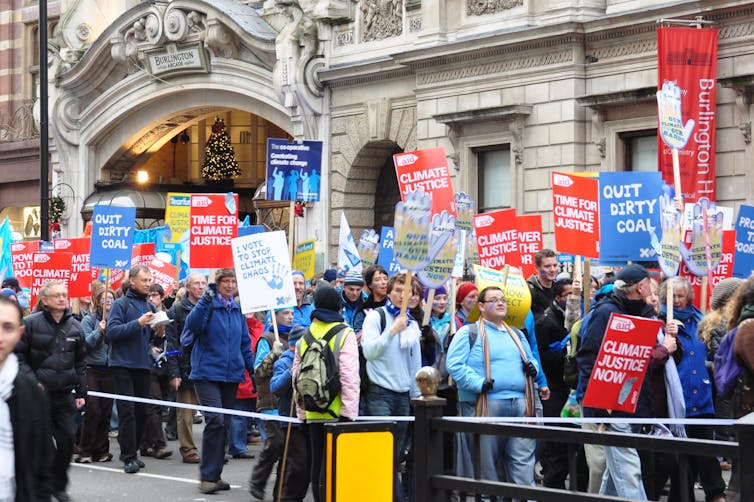 Many people underestimate how much support there is globally for climate action. Wikimedia, CC BY-NC
Many people underestimate how much support there is globally for climate action. Wikimedia, CC BY-NCMany people underestimate just how much support there is globally for climate action, with most people believing they are in a minority. This arguably fosters disengagement and isolation. But it also suggests that as awareness grows and people see their values reflected in others, the conditions for social tipping points may be strengthened.
Reaching this positive tipping point will require more than facts and policy. It will take connection, courage, and collective resolve. Climate mitigation strategies are available, cost effective and urgently needed, and we can still limit warming if we act boldly and quickly, but the window is closing.![]()
Thomas Newsome, Associate Professor in Global Ecology, University of Sydney and William Ripple, Distinguished Professor and Director, Trophic Cascades Program, Oregon State University
This article is republished from The Conversation under a Creative Commons license. Read the original article.
Climate change is a crisis of intergenerational justice. It’s not too late to make it right
Philippa Collin, Western Sydney University; Judith Bessant, RMIT University, and Rob Watts, RMIT University
Climate change is the biggest issue of our time. 2024 marked both the hottest year on record and the highest levels of carbon dioxide (CO2) emissions in the past two million years.
Global warming increases the frequency and severity of extreme weather events, bushfires, floods and droughts. These are already affecting young people, who will experience the challenges for more of their lives than older people.
It will also adversely affect those not yet born, creating a crisis of intergenerational justice.
Caught in the changing climate
In 2025, children and young people comprise a third of Australia’s population.
Given their early stage of physiological and cognitive development, children are more vulnerable to climate disasters such as crop failures, river floods and drought.
They are also less able to protect themselves from the associated trauma than most older people.
Under current emissions trajectories, United Nations research warns every child in Australia could be subject to more than four heatwaves a year. It’s estimated more than two million Australian children could be living in areas where heatwaves will last longer than four days.
A recent report found more than one million children and young people in Australia experience a climate disaster or extreme weather event in an “average year”.
Those in remote areas, from lower socioeconomic backgrounds and Indigenous children are more likely to be negatively effected. That’s equivalent to one in six children, and numbers are rising.
Anxiety, frustration and fear
The impact of climate change on young people’s health and wellbeing is also significant. Globally, young people bear the greatest psychological burden associated with the impacts of climate change.
Feelings such as frustration, fear and anxiety related to climate change are compounded by the experience of extreme weather events and associated health impacts.
Intergenerational inequality is the term on the lips of policymakers in Canberra and beyond. In this four-part series, we’ve asked leading experts what’s making younger generations worse off and how policy could help fix it.
For young people who live through climate-related disasters, they may experience challenges with education, displacement, housing insecurity and financial difficulties.
All these come on top of other issues. These include increased socioeconomic inequality, rising child poverty, mounting education debt, precarious employment, and lack of access to affordable housing.
This means this generation of young people is likely to be worse off economically than their parents.
Not walking the walk
Some key policy figures understand how climate change is turbo-charging intergenerational unfairness.
Former treasury secretary Ken Henry described the situation as an “intergenerational tragedy”, referring to the ways Australian policymakers are failing to address the changing climate, among other crucial issues.
Even Treasurer Jim Chalmers acknowledged “intergenerational fairness is one of the defining principles of our country”.
Yet, the current responses to the Climate Risk Assessment Report suggest it’s not the highest priority.
Climate change was barely mentioned in the May 2025 federal election. The major parties largely avoided the subject.
It was also concerning that the first major decision of the newly reelected Albanese government was approving an extension to Woodside’s North West Shelf gas project off Western Australia until 2070.
This leaves a legacy to young people of an additional 87 million tonnes of carbon dioxide equivalent every year for many years to come.
Raising young voices
Australia’s children and young people are not stupid. Many worked out early that they could not trust governments.
Since 2018, young people have mobilised hundreds of thousands of other children in protests calling for climate action.
Youth-led organisations in Australia, such as the Australian Youth Climate Coalition, have long led campaigns and strategies to address climate change. They are joined by an increasing range of older allies, from Parents for Climate to the Knitting Nannas to the Country Women’s Association.
Domestically, many young people have turned to strategic climate litigation and collaboration with members of parliament on legislative change. They argue governments have a legal duty of care to prevent the harms of climate change.
Thwarted attempts
Beyond accelerating implementation of the National Adaptation Plan, other legislative innovations will help.
In 2023, young people worked with independent Senator David Pocock to draft legislation addressing these concerns.
This bill required governments to consider the health and wellbeing of children and future generations when deciding on projects that could exacerbate climate change.
It was sent to the Senate Environment and Communications Legislation Committee. While all but one of 403 public submissions to the committee supported the bill, in June 2024 the Labor and Coalition members agreed to reject it. They argued it was difficult to quantify notions such as “wellbeing” or “material risk”.
Adding insult to injury, both major parties claimed Australia already had more than adequate environmental laws in place to protect children.
Turning around the Titanic
The Australian parliament may have another opportunity to embed a legislative duty to protect children and secure intergenerational justice. Independent MP Sophie Scamps introduced the Wellbeing of Future Generations Bill in February 2025. As legislation brought before the parliament lapses once an election is called, Scamps is planning to reintroduce the bill in this sitting term.
The bill would introduce a legislative framework to embed the wellbeing of future generations into decision making processes. It would also establish a positive duty and create an independent commissioner for future generations to advocate for Australia’s long-term interests and sustainable practice.
While this bill does not include penalties for breaches of the duty, if passed, it would force the government of the day to consider the rights and interests of current and future generations.
It’s based on similar legislation in Wales, which has worked successfully for a decade.
If nothing else, the Welsh experiment suggests we can take entirely practical steps to promote intergenerational justice, reduce the negative impacts of climate change on young people right now and avert a climate catastrophe threatening our children who are yet to be born.
It may feel like turning around the Titanic, but it must be done.![]()
Philippa Collin, Professor of Political Sociology, Institute for Culture and Society, Western Sydney University; Judith Bessant, Distinguished Professor in School of Global, Urban and Social Studies, RMIT University, and Rob Watts, Professor of Social Policy, RMIT University
This article is republished from The Conversation under a Creative Commons license. Read the original article.

